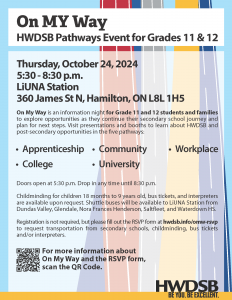
Education and career/life planning helps students develop the knowledge and skills they need to make informed choices for their education, career and life outside school. Students get a chance to learn more about themselves and their opportunities, set goals and make plans to achieve them.
HWDSB schools provide opportunities and supports for all students to plan their individual pathways and make a successful transition to their initial post-secondary destination. The five pathways are: Apprenticeship, College, Community, University and Workplace. Click here to learn more about post-secondary pathways.
 On MY Way – Pathways Event for Grades 11 & 12
On MY Way – Pathways Event for Grades 11 & 12
Thursday, October 24, 2024
5:30 – 8:30 p.m.
LiUNA Station
360 James St N, Hamilton, ON L8L 1H5
On MY Way is an information night for Grade 11 and 12 students and families to explore opportunities as they continue their secondary school journey and plan for next steps. Visit presentations and booths to learn about HWDSB and post-secondary opportunities in the five pathways: Apprenticeship, College, Community, University, Workplace
Click here to learn more about the October 24 On MY Way Event.
Types of Courses in Grades 11 and 12
As you progress to Grade 11 and 12, the range of course options grows from Academic (D), Applied (P), and De-streamed (W) to also include College (C), Workplace (E), College/University (M), and University (U). You should try to keep your opportunities open by taking university and/or college level classes in Grade 11 and 12. To make the most informed decisions about your educational journey, you should consider the following steps:
- Research your program and its prerequisites
- Connect with the Student Services department for academic
- Explore your campus and engage with current students for valuable
- Take part in summer programming provided by your
- Attend orientation sessions to familiarize yourself with university
- Explore scholarships and bursaries specific to your
Choosing a pathway can feel like a difficult decision! To help streamline your options, you should check program requirements, availability, costs, location. You should also discuss options with your family and Student Services department.
Post-Secondary Pathway Timeline
| September to December |
|
| January to February |
|
| April |
|
| May to June |
|
Scholarships, Bursaries and Financial Aid
There are scholarships and bursaries you can choose to apply to depending on your pathway destination after secondary school. School, community, and national awards have different criteria.
At HWDSB, a joint team oversees awards for the entire system. Each secondary school has identified staff who make up its school awards team. Awards information is distributed to students and staff in early February, which outlines the process and timelines for system and school-specific awards. These opportunities are then communicated to students through school award teams. Click here to learn more.
Ontario Student Assistance Program (OSAP)
Ontario Student Assistance Program (OSAP) is a financial aid program funded by both the provincial and federal governments that helps students pay for post-secondary education. You can apply to OSAP as soon as you have been accepted to your school of choice. Students who apply for OSAP are automatically considered for both grants and a loan. OSAP offers funding through:
- Grants: money that you get to
- A student loan: money that you will need to repay once you have completed school. Loans are interest and payment-free while you are attending
Discovering My Pathway
All HWDSB schools provide opportunities and supports for you to plan your individual pathway through secondary school and make a successful progression to your post-secondary destination.
Exploring, revisiting, and modifying the Individual Pathway Plan (IPP) to reflect objectives and interests is critical as you continue your journey and make pathway choices and informed decisions about your future. Click here to learn more about the post-secondary pathways listed below.
Apprenticeships
Apprenticeship is a post-secondary pathway that combines on-the-job training, work experience and technical training that leads to certification in over 150 trades. Employers provide most of the apprenticeship training in the workplace. The remaining training involves in-school sessions offered by approved training delivery agents. Once both school and on-the-job components have been satisfied, you can receive a Certificate of Apprenticeship.
College
There are 27 colleges in Ontario, located throughout the province. Colleges offer a variety of diploma, certificate and applied degree programs. The basic admission requirement for postsecondary programs in the Ontario college system is either an OSSD or any lesser minimum admission requirement as established by a college on a program-specific basis. Programs are career-oriented and geared toward marketable skills.
Community
Community living involves looking ahead to the future and preparing for adulthood. This pathway includes programming, education opportunities, recreation and social activities. Transition planning for post-secondary options will continue at the school level.
University
There are 21 universities across Ontario, offering professional programs in a variety of fields. To attend university, you must attain your Ontario Secondary School Diploma and six of your Grade 12 courses must be completed at the University or University/ College Level. Students need to ensure that they meet the admission requirements for the programs they are interested in taking. Some programs have specific requirements like course pre-requisites, portfolios, interviews or admission tests.
Workplace
You should consider direct entry to the workplace if you have developed practical and essential workplace skills that have prepared you for a specific career without needing to pursue college, university or an apprenticeship first. Workplace is also an ideal pathway for those who want to gain work experience and/or earn money before continuing post-secondary education.
On Your Way
Check out the following links to learn more about the programs, supports and resources available at HWDSB secondary schools.
| Programs | Supports | Resources |
| Programs in Secondary School | Supports in Secondary School | Resources in Secondary School |
Updated on Tuesday, October 22, 2024.

